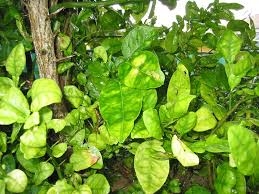A single breakthrough discovery for managing citrus greening in Florida in the future is unlikely, says a new report by the National Academies of Sciences, Engineering, and Medicine. The committee that wrote the report called for a systems approach to prioritize research on the disease and strategically distribute resources for research to effectively manage the disease, which is the most serious threat for citrus growers worldwide.
The disease Huanglongbing (HLB) or citrus greening — associated with bacteria that are spread by a sucking insect, the Asian citrus psyllid — was initially observed more than 100 years ago in Asia and was first detected in Florida in 2005. The infection results in blotchy mottling of leaves, stunting of shoots, gradual death of branches, and small, deformed fruits with bitter juice. Although infected trees do not die right away, they can remain in a steady state of decline for several years. Between 2010 and 2014, acreage of citrus trees in the state declined from roughly 750,000 to 476,000 acres, and production volume has declined by 58 percent since 2005. In Florida, citrus greening has caused a cumulative loss of $2.9 billion in grower revenues from 2007 to 2014, an average of $374 million a year.
The Citrus Research and Development Foundation (CRDF), a $124 million state citrus-industry initiative, has invested nearly 90 percent of its funds in HLB research. CRDF asked the Academies to review its research portfolio and determine if its efforts have followed recommendations outlined in the Academies' 2010 report, which originally called for the organization's creation. The committee found that CRDF was responsive to several recommendations from the previous report, and along with other funders, has advanced our knowledge about the disease. However, HLB remains a serious danger to Florida's citrus industry, having progressed from an acute to a chronic disease throughout the state.
The report notes that significant barriers to progress toward an HLB solution still exist, among them the inability to culture the bacteria in the laboratory, the lack of advanced diagnostics for early disease detection, and the absence of standardized research methodology that would improve the comparability of results across studies. Resolution of any one of these issues would constitute a significant step, according to the report.
The committee recommended continuing support for both basic and applied research for short- and long-term research efforts. In the long run, HLB solutions would likely utilize new technology, such as gene modification and gene editing, focusing on targets that mediate molecular interactions among plant, bacteria, and the vector, the committee said. As interest in using genetic modification in research grows, CRDF should also consider funding research to assess stakeholder acceptance of the technology and expand efforts to educate growers, processors, and consumers to facilitate the eventual deployment of genetically modified citrus lines.
In the meantime, growers in the state will need short-term solutions for the industry to remain viable. The report recommends finding the best suite of strategies to control the disease in different environmental and growing conditions, vector and pathogen pressures, tree varieties, and stages of tree health, which would help growers in Florida and other states where HLB also occurs.
The report also highlights the need to better understand the economic and sociological factors that impact decision-making and behaviors of growers, which influence the adoption of HLB management strategies. CRDF should create accessible databases to support sociological and economic modeling of citrus greening-related research outcomes and application projections.
The report recommends researchers communicate about the outcomes and evaluation of their efforts in a timely and systematic way. Additionally, current approaches to research prioritization and funding based within individual federal and state funding agencies have not led to development of a master plan for HLB research and subsequent management solutions. CRDF should work with other funding agencies to create an overarching advisory panel to develop a master plan for HLB research, communication, and management.
The study was sponsored by CRDF. The National Academies of Sciences, Engineering, and Medicine are private, nonprofit institutions that provide independent, objective analysis and advice to the nation to solve complex problems and inform public policy decisions related to science, technology, and medicine. The National Academies operate under an 1863 congressional charter to the National Academy of Sciences, signed by President Lincoln. For more information, visit http://national-academies.org.
Get the Report:
Attached Images:
